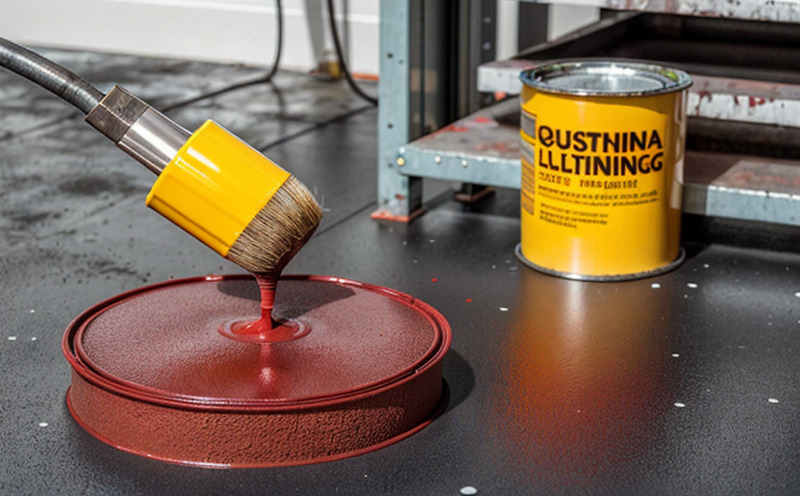ISO 4624 Pull Off Adhesion Strength Testing of Paints
The ISO 4624 standard outlines a method for determining the pull-off adhesion strength of coatings, including paints, on various substrates. This test evaluates how well a coating adheres to its substrate by measuring the force required to remove it from the surface using a peel or shear action. This information is crucial for quality assurance and compliance purposes in industrial manufacturing and processing.
During this testing process, samples are prepared according to ISO 4624 guidelines, ensuring that they represent real-world conditions as closely as possible. The specimens used can range from simple flat panels to more complex geometries like pipes or irregular shapes. Prior to testing, the coating is allowed to cure for a specified period and under controlled environmental conditions.
The pull-off adhesion test involves applying a known force to the coated surface until it fails at either the interface between the coating and substrate or within the coating itself. The force required to achieve this failure point is measured accurately using specialized testing machines designed specifically for this purpose. These machines can apply forces ranging from tens of Newtons up to several kilonewtons depending on the size and type of sample being tested.
Once the test has been completed, the results are analyzed based on various factors such as the peak force recorded during the peel or shear action, any deformation observed in either the coating or substrate, and whether there was cohesive failure within the paint film itself. The outcome provides valuable insights into both the quality of the applied coatings and their suitability for use in industrial applications.
Understanding how different factors influence adhesion performance is essential when selecting appropriate materials for specific environments or processes. Factors such as humidity, temperature variations, aging effects, solvent exposure, and abrasion resistance all play significant roles in determining overall coating durability. By conducting regular pull-off adhesion tests according to ISO 4624 standards, manufacturers can ensure consistent product quality across their production lines while also meeting regulatory requirements set forth by authorities like the U.S. Environmental Protection Agency (EPA).
For instance, industries such as automotive manufacturing heavily rely on coatings that possess excellent adhesion properties since they must withstand harsh environmental conditions throughout their lifecycle. Similarly, in aerospace applications where lightweight yet durable materials are needed for long-term performance, accurate adhesion measurements play a critical role in selecting suitable paints and finishes.
In conclusion, ISO 4624 pull-off adhesion strength testing offers comprehensive insights into the bond between coatings and substrates, enabling informed decisions regarding material selection and process optimization. This knowledge helps companies achieve higher levels of product reliability and customer satisfaction while adhering to global standards for quality assurance.
Applied Standards
The ISO 4624 standard is widely recognized as a key reference for industries involved in the production, application, and evaluation of coatings. It provides clear instructions on how to conduct pull-off adhesion strength tests accurately and consistently across different laboratories worldwide.
Some other relevant standards include:
- ASTM D3359: Standard Test Method for Measuring Adhesion by Tape Test
- EN 1677-2: Determination of Peel Strength of Coatings on Metal Surfaces - Part 2: Use of Manual Testing Machines
- IEC TR 60593: Recommendations Concerning the Application and Interpretation of Pull-off Adhesion Tests
These additional standards complement ISO 4624 by offering supplementary information or alternative methods for measuring adhesion strength. Together, they form a robust framework that ensures accurate comparisons between results from various testing facilities.
It's important to note that compliance with these international standards not only enhances credibility among stakeholders but also facilitates smoother interactions with regulatory bodies and trade partners internationally.
Environmental and Sustainability Contributions
The pull-off adhesion strength test plays a vital role in promoting sustainability within industrial manufacturing processes. By ensuring that coatings adhere properly to substrates, manufacturers minimize waste generation due to improper application or premature failure of the protective layer.
Moreover, reliable adhesion testing helps reduce energy consumption associated with repainting operations by guaranteeing longer-lasting finishes on products like cars, planes, and industrial equipment. This extends the lifecycle of these assets, thereby reducing resource depletion rates over time.
From an environmental perspective, better adherence translates into reduced emissions from recycling processes since less material needs to be discarded prematurely. Additionally, improved coating performance contributes positively towards waste reduction strategies adopted by many organizations committed to greener practices.
In summary, ISO 4624 pull-off adhesion strength testing supports sustainable business practices through optimized resource usage and minimized environmental impact throughout the product lifecycle.
Competitive Advantage and Market Impact
The ability to demonstrate consistent adherence performance of industrial coatings is becoming increasingly important in competitive markets. Companies that invest in robust adhesion testing regimes are better positioned to meet customer expectations regarding product durability and reliability.
By leveraging ISO 4624 standards, manufacturers can differentiate themselves by providing evidence-backed claims about the quality of their products. This translates into enhanced brand reputation and increased market share among discerning customers who prioritize sustainability and performance.
In sectors like automotive manufacturing or aerospace engineering where safety requirements are stringent, adherence tests serve as a critical checkpoint ensuring that products meet rigorous standards before reaching end users. Such transparency fosters trust between buyers and sellers, ultimately driving sales growth for compliant suppliers.
Furthermore, adhering to global standards such as ISO 4624 positions companies favorably in international markets where regulatory compliance is essential. This facilitates smoother trade negotiations and broader market penetration opportunities without compromising on quality or safety aspects.
In summary, investing in comprehensive pull-off adhesion strength testing according to ISO 4624 not only strengthens internal processes but also enhances external competitiveness by meeting high industry standards and fostering stronger customer relationships.





